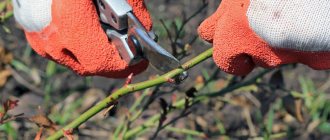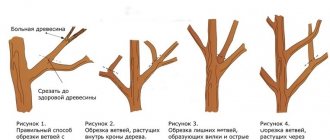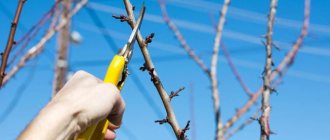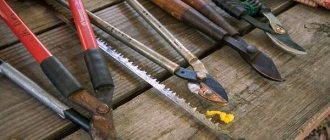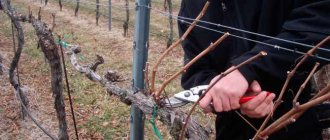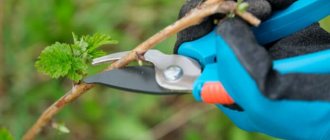When is it better to prune roses: autumn or spring?
Many people believe that pruning roses is completely unnecessary, but this is not true. The denser the flowers, the less light reaches the bushes. Therefore, pruning allows you to thin out the plant, while allowing full access to sunlight. Thus, the rose grows better and blooms longer.
Otherwise, if this event is not carried out, the plant will be weak and will be more susceptible to external influences, including frost, and various diseases. It is also recommended to prune 3 times a year, in all seasons except winter, of course. It is very important to treat shrubs before the onset of cold weather, that is, in the fall, because... a rose can simply turn into a rose hip. But not all types of roses require such treatment.
It is better to prune in autumn
The following types of pruning are distinguished:
- Strong – intended for overgrown, young and weak shrubs
- Moderate pruning is performed if you want to add fullness to the bush.
- Light form - carried out for hybrid tea roses
- Formative - needed to form the shape of the bush
During the procedure, all weak, immature and dried buds are removed. This also applies to weak and diseased stems. It is recommended to remove shoots, because how during the cold period they can rot, which leads to the development of various diseases and fungi.
Another important point when pruning a rose is the use of a sharp instrument; otherwise, uneven, torn cuts are observed, which leads to suppuration and blackening of the bark. In this case, the damaged area must be removed immediately.
What roses are pruned in autumn, summer, spring: varieties
Most gardeners love roses very much, which is why today you can find many varieties and hybrids of this kind of flowers. Of course, such incredibly chic and beautiful shrubs with fragrant buds require appropriate care, so if you want to grow such a durable shrub as a rose on your site, you should first remember some rules for caring and growing this plant.
Of course, the first thing is cutting off the flower. There are various pruning methods, which are described in the first paragraph of the article, but not every type or hybrid of plant is suitable for one or another type of pruning. Roses are also pruned in each season of the year for various reasons, for example:
- In spring, roses are pruned to form bushes; this is done for decorative purposes.
- In summer, roses are pruned if weak shoots appear that do not bear flowers. A similar procedure is also carried out to obtain commercial cut flowers.
- In the fall, preventive cutting is carried out in order to prepare the flower for winter.
The method and season of pruning also depend on the variety, for example:
- Jens Munk, Robusta, Rugelda and other representatives of rugose rose hybrids do not require autumn pruning, because... their shoots do not resort to the ground and do not need shelter.
- Hybrid tea, polyanthus, and miniature roses are cut in half.
- Low and weakly growing shrubs of Muttertag varieties are pruned very short in the spring. Thanks to this pruning, the bushes develop well and send out new young branches, produce many new sprouts and shoots that can bloom even in the same year.
- In order to get early flowering of vigorous varieties such as Marysa or Orangw Triumph, light pruning is necessary in the first year after planting.
- But for roses that belong to the floribunda group, mixed pruning will be required in the fall, in which it is planned to trim some of the stems lightly to obtain early flowering, and the rest heavily to stimulate the growth and development of fruits.
Pruning roses
- Varieties Burburg, Exceisa, Dorothy Perkins and many others belong to the climbing roses with small flowers of the Rambler group. They bloom once along the entire length of the branches for 30 days. To stimulate rapid plant growth, before planting, you need to cut the branches to a height of no more than 35 cm. This type of plant needs to be trimmed only in the spring, and only the tops, essentially for decorative purposes.
- Such varieties as Schwanensee, Ramira, Goldster, etc. belong to climbing large-flowered roses, and practically do not require pruning, only decorative pruning is performed in the summer. Also, a similar procedure is needed when planting a plant in the soil, in this case you need to trim off the roots and tops a little, leaving 25-30 cm in length.
- Lidia, Westerland belong to semi-climbing bush roses, which are accompanied by long and continuous flowering. Of course, such flowers should be carefully looked after and in the first year of life, shorten 1/3 of the length; in subsequent years, it is necessary to monitor the aesthetic appearance of the plant. Before planting, you need to lightly trim the roots and tops.
Optimal period
For each region of the country, the timing of the event is different. Central Russia, including the Moscow region, begins work in the second half - end of October. Ural, Siberia, Leningrad region - roses are pruned in September - early October. Southern regions: Crimea, Kuban, Stavropol region - do this in November.
Trimming rose buds (Photo used under standard license ©azbukaogorodnika.ru)
But since the vagaries of nature are unpredictable, the above deadlines are a conditional guideline. First of all, experienced gardeners take into account local climatic conditions and do not forget to monitor the weather forecast.
They begin trimming the bushes by choosing a clear, sunny, windless day. The first night frosts should serve as a signal for pre-winter preparation. However, it is advisable that there is a small margin of time left before the onset of stable cold weather - 7-10 days.
Important! Early pruning of rose bushes leads to the growth of young shoots, which weaken the bush, preventing the plant from fully preparing for winter.
Pruning roses in autumn, summer, spring: diagram
In order to grow a lush rose bush, which is accompanied by good growth of new shoots, it will require a lot of effort, fertilizer and, most of all, regular pruning and flower care. Of course, this procedure must be carried out correctly in order for your plant to please you for as long as possible.
- Spring pruning is carried out in order to remove excess weeds and debris after winter; in other words, sanitary “cleaning” is carried out; it is carried out with the onset of cold weather. And, of course, pruning is done to shape the growth of the bush.
- If the bush is too thick, it needs to be thinned out, leaving 4-5 of the strongest stems. The cuts are made with sharp pruning shears at an angle of 45 degrees.
Proper pruning
- In spring, it is recommended to prune all types and varieties of roses.
- During the hot season, it is also worth paying attention to the growth and development of roses, watering and removing weeds in a timely manner, and monitoring pests, especially for bushes older than 3 years.
- In summer, it is worth removing faded flowers, because this way the plant will be able to retain more strength for subsequent flowering.
- Before the onset of severe frosts, almost all types of roses must be pruned. This does not apply to those varieties that do not need shelter. All the rest should be cut to the height of the covering material.
You need to trim the stems exactly at any time of the year, because if the surface is damaged, this can negatively affect the development and growth of the plant. It is best to carry out the procedure with a sharp knife or pruning shears, especially if you are a beginner gardener.
Basic rules for pruning
During wintering, it is customary to leave no more than 7 shoots on the bush. The procedure for removing and shortening the stems begins when a stable outside temperature reaches about -2 degrees. In the middle zone this is the end of October - beginning of November.
Trimming tools
The main tool for thinning bushes is a garden pruner, but experienced gardeners also use a sharp knife. To cut thick branches that are more than 2.5 cm in diameter, you may need a hacksaw.
Preparation for pruning
By the end of September:
- Stop watering and loosening the soil under the roses to slow down the growth of shoots.
- Late buds are prevented from blooming by pinching them.
- If there are heavy rains, a canopy is pulled over the rose garden.
- Hill up the bushes to a height of 10-20 cm.
When and in what month is it better to prune roses in the fall in the middle zone: timing
Of course, the event of pruning roses should be carried out as often as possible, about three times a year, or as needed, in spring, summer, and autumn, but it is very important to ensure proper pruning just before winter, because the onset of cold weather can completely destroy the unprepared plant.
Autumn pruning should be carried out during the period when the temperature at night reaches at least +10°C, this is approximately the end of October. After pruning, you need to immediately worry about an antifungal agent; of course, if there are a huge number of shrubs, then such a task is quite troublesome, but at the same time you will definitely extend the life of the plant in the winter and protect it from various diseases.
Pruning in autumn
You also need to remember that before winter, after pruning, you must remove all leaves from the stems. Otherwise, the leaves will continue the process of photosynthesis and simply rot, which can negatively affect the plant itself. In addition, most of the spores of pathogenic fungi are located on the leaves, which is why all leaves and excess shoots should be removed not only from the plant, but even from the site itself, and it is best to burn it.
Despite the fact that you need to prune the rose closer to the onset of frost, caring for the plant should begin at the beginning of autumn, that is, starting in September, it is at this moment, after the rose has bloomed, that you should begin fertilizing, pruning and slowly covering the bushes. With the onset of the slightest cold weather, the plant weakens and, of course, may react negatively to changes in the environment. In the future, this may affect the growth and timely flowering of the rose.
Care after pruning
2 weeks after pruning, the plants are fed with phosphorus and potassium fertilizers so that the roses can gain strength and endure the harsh winter. The bushes do not require watering; they gradually begin to hibernate.
It is necessary to cover rose bushes when the temperature reaches -5 degrees. Oak leaves, spruce branches, sawdust, and peat can be used as covering materials. You can place arches over small bushes and cover them with lutrasil or spunbond.
How to properly trim roses in the fall for the winter, to what height should they be cut before covering?
Knowledgeable rose growers never forget about pruning roses before winter, which is done in mid-to-late autumn, because it has incredible benefits for the plant. First of all, this is one of the most effective ways to prepare a plant for frost and cold and, of course, in this way you can extend the life of the plant much longer.
Cutting height
By pruning roses for the winter, you can provide them with:
- Abundant growth of new, young branches and shoots
- Full development of the root system, which contributes to better nutrition and, accordingly, the development and growth of the plant itself
- Thanks to the improvement of the root system, and the fact that the rose does not waste energy on renewing old and unnecessary shoots, a large amount of nutrients appears in the plant
- If the pruning procedure is carried out correctly with the addition of antifungal solutions, rose bushes are much less likely to be exposed to infections and external negative influences and fungi.
Pruning roses
The pruning height depends on the type of bushes themselves, for example:
- Large-flowered bushes are pruned by 1/3, leaving 8 buds on the shoots.
- Medium pruning is not suitable for bud-covering and climbing varieties, but for other types of plants it is excellent and is considered the easiest form of pruning, which spares rose bushes and the plant as a whole. It leaves no more than 5-7 healthy kidneys.
- Short pruning is suitable for small-flowered and polyanthus roses, leaving 2-3 buds. In this case, the winter should not be harsh, without severe frosts, in which case the flower may die.
- In park and climbing varieties, only damaged and old dry shoots are pruned.
- Ground cover roses do not require pre-winter pruning.
Planting a plant in the garden
It is recommended to purchase grafted planting material in the autumn months. The roots should be covered with moss or peat and wrapped in film. Plants can be easily preserved until planting. It is important that they are stored in a cool place.
Landing place
For roses, you should choose a comfortable place on the site that is well lit and not blown by the wind. It is best to plant plants in the southern part. The substrate must be loamy and neutral in acidity. The soil for planting is first fertilized with organic matter. There should be no groundwater near the surface.
Popular: Top 5 varieties of rhynchostilis orchid for open ground
Proper preparation of soil for scrub roses
The soil for the future rose garden should be sorted out and cleared of debris and weed roots. 14 days before planting the seedlings, the soil should be dug up. The day before planting, holes should be dug in the garden bed. Rotted mullein and compost should be added to each hole. Additionally, you can enrich the soil with ash.
Landing period
The planting time depends on the climate zone; for example, in the southern regions of the country, roses can be planted in the first days of autumn. A month before frost is enough for the plants to have time to grow and not freeze in the winter.
In areas with colder climates, planting should be postponed until spring. If the root system of the seedling is closed, then planting is best done in spring or autumn. With the roots covered, plants can be planted from spring to autumn.
Pruning climbing roses in the fall for beginners: diagram
Many people believe that it is not necessary to prune climbing roses for the winter, but this procedure is simply necessary for the plant for further growth and strengthening. Pruning allows you to prepare shrubs as much as possible for winter frosts and helps fight fungi and various diseases.
Also, this is necessary for the formation of a bush, because climbing roses can grow to very large sizes. For this kind of shrubs, moderate pruning is used, aimed at removing stems that are too long; bushes that are too dense should be thinned out so that the rays of the sun can fully reach the entire plant, in which case a speedy flowering is ensured and the shrub can fully develop.
Pruning a climbing rose
Also, first of all, you should worry about damaged branches, dry buds and leaves; they also need to be removed and kept away from the plant. After all, rotten leaves and stems are carriers of diseases and harmful fungi. If the bush blooms once, then the buds on it grow on last year’s shoots; after flowering, they need to be cut to the very bottom. In shrubs of this type, it is worth leaving 3-5 of the strongest shoots for the winter and cutting out the rest.
In re-blooming plants, branches with flowers are formed on the main shoots over the course of 3-4 years. If such branches do not appear, it is worth removing such a shoot. Such a bush should consist of 3-7 strong flowering branches. For all climbing bushes, there is one rule for pruning - you should not prune roses in the spring, only in case of freezing. This should not be done just because flowering occurs on last year’s overwintered runs, otherwise the shrub may not bloom. Also, it is worth remembering that climbing roses need to start pruning only from the second year of life.
Spring pruning of roses: description of technology
Roses are incredibly beautiful flowers, and can delight us with their beautiful buds and aroma for many years, but at the same time, growing a lush and beautiful shrub in your garden is not an easy task, and not everyone succeeds.
- The key to excellent plant growth and development is timely pruning and removal of unnecessary weeds and debris.
- Basically, pruning is carried out in the fall, but not all flowers need spring and summer procedures.
It is necessary to resort to spring pruning in the following cases:
- You can start around the end of April-beginning of May, at this time the buds in the lower part of the rose bush begin to swell
- If you need to form a flower for decorative purposes
- When shoots freeze (with brown, sometimes black core) after winter
- If the buds begin to develop below the cut, it is worth cutting the shoot to the bud line
Pruning in the spring
It is worth remembering that if you prune too early, you can injure the plant from the spring cold. Rose is a more heat-loving plant, and it is worth preparing shrubs for cold weather in order to extend the life of the flower. Late pruning also negatively affects the behavior of the plant, because All energy goes into the formation of new shoots, which affects flowering.
The main thing is that the pruning is correct and timely, because in this case it is possible not only to form a bush, but also to influence the renewal of the plant, which in turn affects the full development and resistance to various negative influences.
Summer pruning of roses: diagram
Summer pruning of roses is carried out purely symbolically, for preventive purposes. At the same time, faded dry buds are cut off, which can stimulate re-blooming in those varieties that are characterized by this.
Pruning in the summer is best done immediately after the buds have faded; the cut should be made approximately 8-10 mm above the healthy buds, which are located in the axils of the leaves; they can be clearly seen after the leaves have fallen.
The cut must be made smooth, without notches, with an inclination towards the bud of no more than 0.5 mm, thus the cut will be correct. If this is done at a different angle, the bud will retain moisture and will rot over time.
Summer pruning
Summer pruning can provide a number of benefits, such as:
- The plant does not need to expend energy on the formation of seed material
- Improves decorative appearance
- Pruning promotes better resistance to fungi and various diseases
- The growth and development of new buds is stimulated, if provided for by the variety
- And of course, rejuvenation and almost renewal of the plant occurs
In this way, the rose can be prepared for subsequent temperature changes, as well as for cold weather in the future.
Pruning roses: tips for beginner gardeners
The rose is a rather demanding plant, and if you want it to please you for many years, you should pay due attention to such a whimsical flower. In addition to the fact that the plant needs to be properly fed, fertilized, watered on time, protected from fungi and diseases, it is also necessary to trim the bushes in a timely manner.
In order to prune rose bushes correctly, it is worth remembering the following rules:
- Work only with gloves to avoid injuring your hands
- Cut only with a sharp tool, it is best to use pruning shears
- It is better to disinfect the instrument with a solution of potassium permanganate or a solution of copper sulfate
- Carry out the procedure only in dry sunny weather
- The cut should be at an angle of 45 degrees to allow water to drain and not accumulate.
- After circumcision, treat the cut area with garden varnish or other antifungal agent
- It is better to start pruning with thinning, so it will be more convenient to consider what and where to correct
- Next, it’s worth removing old and damaged shoots
Tips for pruning roses
Also, today decorative and beautiful roses are increasingly grown in bushes, they also need to be pruned in a timely manner, and there are also rules for this:
- If the flower bears large buds, then after pruning there should be at least 3 buds left
- Renew the rose using pruning methods if it does not bloom
- If you want to grow slender single roses, you do not need to trim the tops, only weak shoots
- After the rose has bloomed and the buds have dried, you need to trim them so that the rose does not waste energy on reproduction
If you want to propagate your indoor rose, you need to take a healthy cutting with 3 buds from the middle part of the branch. The cuttings need to be placed in water, and when roots appear, immediately transplanted into the ground.
Pruning times in different regions
In different regions, pruning occurs at different times. Autumn in the Leningrad region is famous for rain and winds. To shorten branches and remove excess shoots, choose a dry, clear day in mid-October. To obtain even and smooth cuts on bushes, you need a high-quality tool. The wounds are immediately treated with garden varnish or sprinkled with ash. After a few weeks, the plants are covered with sawdust, peat, and covering material.
In Siberia and the Urals, winters come quickly and are characterized by strong drops in temperature. Therefore, in these parts, roses grafted onto rose hips will better withstand extreme conditions. The shoots are not shortened too much at the end of September and the rose bushes are covered after 2 weeks.
